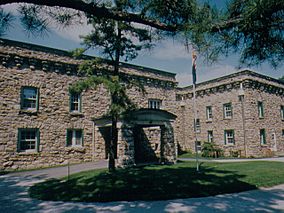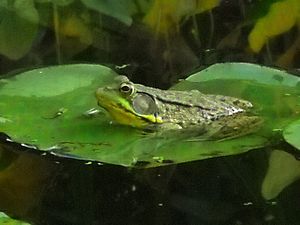Kings Gap Environmental Education facts for kids
Quick facts for kids Kings Gap Environmental Education Center |
|
|---|---|
|
IUCN Category III (Natural Monument)
|
|

The "mansion" at Kings Gap
|
|
| Location | Cumberland, Pennsylvania, United States |
| Area | 1,454 acres (5.88 km2) |
| Elevation | 801 ft (244 m) |
| Established | 1973 |
| Governing body | Pennsylvania Department of Conservation and Natural Resources |
| Website | Kings Gap Environmental Education Center |
Kings Gap Environmental Education Center is a large Pennsylvania state park covering 1,454-acre (588 ha). It's located in Cumberland County, Pennsylvania, on South Mountain. The state of Pennsylvania bought this land in 1973. It was purchased from the C. H. Masland and Son Carpet Company. Kings Gap is a great place to learn about nature and enjoy the outdoors.
Contents
Exploring Kings Gap History
Early Forest Use: Charcoal Making (1750-1900)
The name "Kings Gap" has been around for a long time. No one knows exactly where it came from. The forests here were once used to make charcoal. This happened from the 1700s to the late 1800s.
Before coal was discovered, charcoal was the main fuel. It powered the iron furnaces nearby. These furnaces needed huge amounts of charcoal. One furnace could use the charcoal from one acre of forest each day!
The forests on South Mountain were cut down every 20-25 years. This was to feed the nine iron furnaces in the Kings Gap area. That's why the forest you see today is relatively young.
Making charcoal was a skilled job. Workers called "colliers" cut and stacked wood in winter. They piled the wood into a cone shape around a chimney. This was called a hearth.
The colliers carefully controlled the fires for 10 days to two weeks. They had to keep the wood smoldering to turn it into charcoal. It was a dangerous job, and they lived in simple huts nearby. When coal was discovered, the need for charcoal disappeared.
You can still see signs of these old charcoal hearths. Look for flat, dry spots in the forest. They are about 30-50 feet wide. Sometimes, you can even find small pieces of charcoal on the ground.
The Cameron Family and the Mansion (1906–1951)
Around 1906, James McCormick Cameron bought a lot of land here. He was from a famous family in Harrisburg, Pennsylvania. In 1908, he built a huge 32-room stone mansion as his summer home. Today, this building is used as a training center and offices.
James McCormick Cameron's grandfather, Simon Cameron, was a U.S. Senator. He even served as Secretary of War for Abraham Lincoln. James's father, Donald Cameron, was also a U.S. Senator.
The family made a lot of money from banking, steel mills, and railroads. James McCormick Cameron continued the family's business success. He bought 2,700 acres of land. He also made sure the land was well cared for.
The Mansion and Other Buildings
The mansion is about 200 feet long. It's made from stone found nearby. It looks like an Italian villa with its flat roof and large windows. The inside structure was built with steel-reinforced concrete. This was very new at the time. The mansion was designed to be as fireproof as possible.
The ice house is 15 feet tall above ground and goes 10 feet deep. The Camerons used it to store vegetables. Ice was brought from Laurel Lake until 1931.
The garden had stone walls. It provided vegetables for the family. Today, a fence keeps deer out.
The water tower holds 10,000 gallons of water. It still supplies water to the buildings today. A pump house at the bottom of the mountain used to send water up to the tower. Now, a well at the pump house is the water source.
The carriage house was once a stable for horses and carriages. Now, it's the center's maintenance building. It even had an automatic carriage wash!
The generator building once held gasoline engines. These engines made electricity for the mansion in the 1930s. Now, the center uses public electricity.
The caretaker's house was where the caretaker lived all year. It's now a private home.
The Masland Family's Influence (1951-1973)
After Mr. Cameron passed away in 1949, the C. H. Masland and Son Carpet Company bought the mansion and 1,430 acres. They updated the mansion with new carpets and furniture. It became the "Masland Guest House."
The company used it to host clients and train employees. The bedrooms even showed off different Masland carpets!
The Masland family also helped manage the land. They planted 30,000 pine trees in a 42-acre area. This was in the 1950s. They also built the pond, which is now used for studying water life.
Eventually, the company decided to sell Kings Gap. It was no longer practical to run it as a guest house.
Protecting Kings Gap for the Future
In 1973, the state of Pennsylvania bought the mansion and land. This was done with help from the Nature Conservancy. The environmental education center opened in 1977. The training center followed in 1980.
In 1991, the training center was named after William C. Forrey. He was the director of the Pennsylvania Bureau of State Parks. He helped a lot with getting and growing Kings Gap.
Environmental Education Programs
Kings Gap Environmental Education Center is one of four centers like it in Pennsylvania. The Pennsylvania Department of Conservation and Natural Resources runs these centers. They offer programs for students, teachers, and the public. You can learn about nature and the environment here. Call Kings Gap at (717) 486-3799 for more information.
Fun Activities and Recreation
Hiking and Picnicking
Hiking and picnicking are very popular at Kings Gap. There are many picnic tables where you can enjoy a meal.
Orienteering Adventures
Kings Gap has three permanent orienteering courses. Orienteering is a sport where you use a map and compass. You navigate a special course to find checkpoints. You can get maps and information at the center office. They also offer beginner programs in the fall and spring.
Hunting Opportunities
Hunting is allowed on several hundred acres of Kings Gap. Hunters must follow the rules of the Pennsylvania Game Commission. You might see gray squirrels, turkey, and white-tailed deer here.
Exploring the Trails
There are about 20 miles of trails at Kings Gap. They start from 19 marked trailheads. You can explore different parts of the park on these trails.
Nature and Wildlife at Kings Gap
Kings Gap Environmental Education Center is home to many wild plants and animals. You might see Turkey vultures flying high near the top of the mountain.
Reptiles and Amphibians
Many reptiles live here, like the box turtle, five-lined skink, copperhead snakes, and timber rattlesnakes.
In springtime, you'll find "vernal pools." These are temporary ponds that fill with water from melting snow and rain. They are important breeding spots for amphibians. You might see wood frogs, spotted salamanders, and spring peepers here.
Diverse Plant Life
The plant life is also very varied. You can find wild blueberry, huckleberry, and mountain laurel. There are also large groups of chestnut oak, white pine, larch, and Douglas fir trees.
Different Areas of the Park
Mansion Day Use Area: Views and Wildlife
The center's offices and the Mansion Day Use Area are at the top of the mountain. It's four miles from the park entrance. The patio of the mansion offers amazing views of the Cumberland Valley. You can often see turkey vultures soaring here.
This area is a good home for many reptiles. These include the box turtle, the five-lined skink (a type of lizard), the northern copperhead, and the timber rattlesnake. You might see them hunting rodents along the stone walls. Remember to respect these snakes and give them space. The timber rattlesnake is a "candidate species" in Pennsylvania. This means it might become endangered or threatened.
The forest here is mostly chestnut oak trees. Blueberries, huckleberries, and mountain laurel grow underneath. The Woodland Ecology Trail is a special path with signs. It helps you learn about this oak forest.
The Educational Garden
The garden, surrounded by a low stone wall, was once used to grow vegetables. It's now an educational garden. It teaches people about the benefits of plants.
The garden has three main areas. The herb garden shows different herbs for cooking, healing, and smelling nice. The wildlife habitat garden uses native plants. It shows how you can create a wildlife friendly space in your own yard. There's also a compost garden. It shows seven different ways to make compost.
Pine Plantation Day Use Area: A Different Forest
Near the entrance of Kings Gap, you'll find the Pine Plantation. This area feels different from the rest of the forest. It's a cool, shaded place with white pine, Douglas fir, and larch trees. The C.H. Masland and Sons Carpet Company planted this forest in the 1950s. It was an experiment to grow trees.
In the winters of 1995-97, some trees were removed. This helped the remaining trees grow healthier. It gave them more sunlight, water, and nutrients.
The Whispering Pines Trail goes through this plantation. It's a paved trail with signs that explain the coniferous forest.
This pine forest is home to animals that like this type of habitat. You might hear a red squirrel chattering. In winter, you could spot a red-breasted nuthatch looking for food on the tree bark.
In spring, you'll see several vernal ponds. These temporary ponds are important breeding spots for amphibians. This includes spotted salamanders, spring peepers, and wood frogs.
Kings Gap Hollow Day Use Area: Pond and Stream Life
This area is two miles from the park entrance. It has a beautiful pond and a mountain stream. It's a great place for environmental education programs. This is because it has many different habitats.
Kings Gap Hollow Run: A Special Stream
Kings Gap Hollow Run is a stream fed by a spring. Sometimes it dries up, showing its stony bottom. But in spring, when the water is high, many water animals live here. You can pick up a stone and see black fly larvae. They cling to the stone and filter food from the water. Even though adult black flyes can be annoying, their larvae mean the water is clean!
The stream has good water quality. However, chemical tests show low pH and alkalinity levels. This means the stream can't easily "buffer" or neutralize acid. So, if acid rain or snow enters, the pH level can drop. If the water becomes too acidic, it can't support life.
Wetlands and Pond Life
The forest around the stream has wetland areas. You'll find sphagnum moss, cinnamon ferns, skunk cabbage, and tulip trees. In late spring, you might see the wildflower "fly poison."
The pond is full of aquatic animals. These include frogs, salamanders, turtles, snakes, and many water insects. A small floating platform in the pond is a safe spot for painted turtles and water snakes to sunbathe. Students also use the pond to study aquatic life.
The White Oaks Trail winds through an oak forest here. This paved trail has signs that explain the forest's ecology.
Nearby State Parks to Explore
Here are some other state parks within 30 miles (48 km) of Kings Gap Environmental Education Center:
- Big Spring State Forest Picnic Area (Perry County)
- Caledonia State Park (Adams and Franklin counties)
- Codorus State Park (York County)
- Colonel Denning State Park (Cumberland County)
- Fowlers Hollow State Park (Perry County)
- Gifford Pinchot State Park (York County)
- Little Buffalo State Park (Perry County)
- Mont Alto State Park (Franklin County)
- Pine Grove Furnace State Park (Cumberland County)



